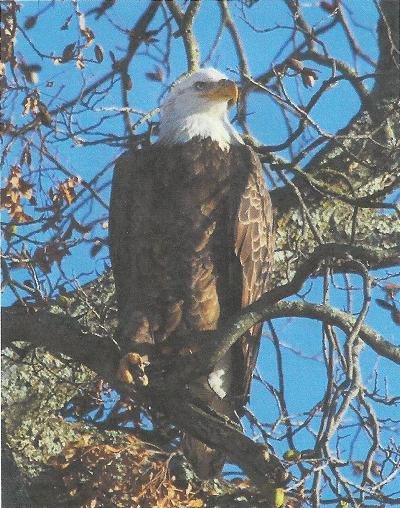 |
Canku Ota
|
 |
|
(Many Paths)
|
||
|
An Online Newsletter
Celebrating Native America
|
||
|
February 2017 - Volume
15 Number 2
|
||
|
|
||
|
Eagle Update
|
||
|
by Bree Dunham, CPN
Eagle Aviary Assistant Director
|
||
The holiday season always seems to be hectic, and this season
the aviary was no exception. November is National American Indian
Heritage Month and with so many relatives coming in to visit their
families over the holidays, we had a surge in calls for appointments
to visit the aviary and our calendars filled up quickly. With all
the extra hustle and bustle, we completely missed the deadline for
December’s paper. But there has been much to share when it
comes to Wadasé Zhabwé. Our last article ended as Wadasé left September 20 after
being here for eight days. Until that visit she had only been at
the aviary seven days since the beginning of 2016. We were thrilled
to see her but when she left we couldn’t help but wonder if
there would be eight months before her next visit. However, we weren’t
left wondering that for too long. Less than three weeks later, on
October 9 Wadasé showed up at sunrise. Every eagle loudly
announced her arrival as she made several passes around the aviary
pasture before coming to land on the top of the half round enclosure.
She stayed for five days before heading out again and with this
visit, we wondered if this pattern might become more of her routine
for the winter. Consequently we watched the calendar and waited
in hopes of another visit. On the 18th day, October 31, she was
back again. This time she stayed for a full week. During these visits
we would normally see her every morning at sunrise. She would spend
most of the morning hanging out on the enclosure with the eagles.
Occasionally she would find the highest perch that would support
her in the very top of her pecan tree out front so she could keep
an eye on the entire property. During the middle of the day we often
didn’t see her. Telemetry shows After her last departure on November 6, we were optimistic she
would be back in a few weeks. Once again, we counted down the days
as we waited for her next visit, but 18 days came and went. Along
with 20, 25 and 30 days came and went with no sign of Wadasé.
In fact, studying her telemetry, we noted that she had been less
than 10 miles from the aviary on November 24. That date, 18 days since her previous visit, was right on schedule
according to the time between the last three visits, but she hadn’t
come to the aviary. We assumed this might possibly count towards
her being in the area to visit and we started the countdown again. With an article due for the January edition of the paper we
sat down to compile the all the specific data needed and finish
our article after lunch. Just as we were finishing up we heard the
eagles begin to vocalize in a familiar tone. There she was, perched
out front. Wadasé was home again! She is notorious for coming home at the last minute and causing
several edits or entirely new articles and, in all probability,
causing a few grey hairs for our public information department,
who always seem to be waiting on Wadasé articles from the
aviary. Wadasé arrived just ahead of the papers deadline
and a substantial cold front that may bring our first snow of the
season. Her timing is impeccable. But whether it is 18 days or 30
days between visits, there seems to be a fairly consistent pattern
emerging in her returns to this area and we hope that it will continue
throughout the season. In all of 2015, we saw her just 28 days out
of the year and she has been here 21 days in the last three months.
Hopefully, spending more time here is an indicator that she may
be thinking more about nesting nearby and bring a male back with
her. We will certainly keep an eye out for her “plus one”
but today simply is a blessing to see Wadasé perched out
front on her crook soaking up the last light as the sun sets. For us, there are no words to fully express what seeing her here again really means. There has never been another tribe that has had such a relationship with an eagle that we know of in modern history, possibly ever. Wadasé Zhabwé is truly a unique and rare gift. We are just humbled to continue to share her story. As always we encourage you to keep your eyes out for Wadasé if you are near the areas she frequents. For more information about the CPN Eagle Aviary or to read previous Wadasé updates visit www.potawatomiheritage.org. Send your encounters with Wadasé or any other eagles in Oklahoma or wherever you may be to us at aviary@potawatomi.org.
CPN
Cultural Heritage Center |
|||||
|
|
|
|
||
|
|
||
| Canku Ota is a free Newsletter celebrating Native America, its traditions and accomplishments . We do not provide subscriber or visitor names to anyone. Some articles presented in Canku Ota may contain copyright material. We have received appropriate permissions for republishing any articles. Material appearing here is distributed without profit or monetary gain to those who have expressed an interest. This is in accordance with Title 17 U.S.C. Section 107. | ||
|
Canku Ota is a copyright ©
2000 - 2017 of Vicki Williams Barry and Paul Barry.
|
||
 |
 |
|
|
The "Canku
Ota - A Newsletter Celebrating Native America" web site and
its design is the
|
||
|
Copyright ©
1999 - 2017 of Paul C. Barry.
|
||
|
All Rights Reserved.
|
||

